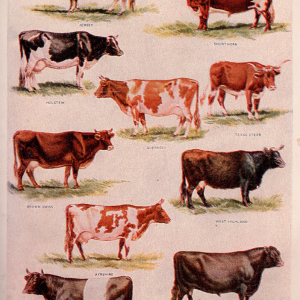
The second SoW-AnGR by the FAO reviews the developments that have been made in the area of using, developing and safeguarding the genetic resources (i.e. the diversity of breeds) of our mammalian and avian livestock since the first SoW-AnGR report was released in 2007.
These extensive and detailed reports are the outcome of an initiative by the Commission on Genetic Resources for Food and Agriculture (CGRFA) and are the product of a global assessment of the state-of-play, with contributions from 129 countries.
This ~600-page report is divided into 5 sections:
- Part 1 addresses the state of livestock genetic diversity in general: it considers the origins of livestock diversity; the current status of animal genetic resources (AnGR) and threats to them; the value that genetic diversity has for agriculture and individuals; the specific genetic variations, or adaptive characteristics that are important for global livestock rearing; and the links between genetic diversity of livestock and human nutrition.
- Part 2 considers the implications of wider changes in livestock production systems for management of AnGR.
- Part 3 presents the analysis of reports submitted by 128 countries concerning the capacities for managing AnGR, including a consideration of countries’ capacities for characterising, making inventory of and monitoring breeding programmes, conservation programmes and the use of reproductive and molecular biotechnologies. It also considers the legal and policy frameworks which affect AnGR management.
- Part 4 outlines the most up-to-date methodologies, tools and techniques used in managing AnGR, including the technical, policy and logistical operations involved.
- Part 5 concludes the report by identifying the key challenges to AnGR posed by current trends in livestock production and details the action that is needed to address these, in the areas of characterisation and monitoring of AnGR, their sustainable use and development, the conservation of AnGR, and the role of policies, institutions and capacity-building.
The report identifies the current total AnGR to comprise 38 distinct species, including 8774 separate breeds, and identifies the major benefit of this diversity (and of maintaining this diversity in the future) as being the capacity for adapting to changing pressures, particularly in light of climate change and emerging diseases. The report finds that 17% of breeds are at risk of extinction and raises the concern that not enough is known about the specific beneficial traits of certain endangered breeds, which might be lost before they can be used. Major threats to AnGR are identified as being indiscriminate cross-breeding (which is a particularly prevalent problem in developing countries where breeding stock is imported), insufficient management policies and institutions, and poor disease control.
The report also highlights positive progress that has been made, including the establishment of gene banks in 64 countries and 41 more in the pipeline, the emergence of new genomic technologies, and the vastly increased recognition that the issue of livestock genetic diversity is now receiving in policy agendas.
Several key recommendations are made in light of the report’s findings (these build on or complement the recommendation of the 2007 Global Plan of Action for Animal Genetic Resources), emphasising the need for: improved assessments of the threats to AnGR; the strengthening of institutional frameworks for managing AnGR; the strengthening of breeding strategies to take maximum advantage of the genetic diversity available; and the expansion and diversification of conservation programmes.
Citation: FAO (2015) The Second Report on the State of the World’s Animal Genetic Resources for Food and Agriculture [Scherf, B.D. and Pilling, D. (eds)]. FAO Commission on Genetic Resources for Food and Agriculture Assessments. Rome
Read the full FAO/CGRFA report here
See also this infographic summarising the key findings of the report and see further coverage and analysis of the report at the following links: [FAO Press Release] [UN Press Release] [CGRFA Website] [IISD Website]
You can find related resources in the Research Library categories on Animal Issues, Governance and Policy and Bioeconomy and Technology, as well as in the keyword categories: genetic diversity, adaptation policies, breeding, trends and projections and livestock systems.







Post a new comment »